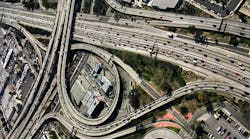America’s infrastructure is the oldest on record and in desperate need of repair and new construction. What’s less obvious is whether President-elect Donald Trump’s plan to spend big will have as much oomph for the economy.
Trump has discussed investment proposals, which include roads, bridges and airports, ranging from more than $500 billion -- double what Democratic opponent Hillary Clinton sought -- to $1 trillion over a decade. He said in his victory speech early on Nov. 10 that he aims to make America’s infrastructure “second to none” while putting millions of people to work and doubling economic growth.
The timing is ripe: The average age of the nation’s fixed assets in 2015 was 22.8 years, the oldest in data back to 1925.
“There’s no doubt we have a dire need to address the crumbling infrastructure,” said Nariman Behravesh, chief economist for consulting firm IHS Inc. in Lexington, Massachusetts. “Whether this happens is a different story, and how much actually gets spent is a little hard to fathom.” Maybe “by 2018, we could start to see some economic impact, but it’ll be fairly small.”
Upgrading stressed infrastructure garnered increasing bipartisan appeal in recent years yet not much got done, partly because of differences over how to fund it and how much money to set aside. What’s more, budget-constrained state and local governments shied away from more spending and borrowing in the aftermath of the recession.
Trump’s plan “does offer the potential of supporting job creation in the short run, more importantly supporting and expanding the economy’s capacity in the medium run,” Larry Summers, former Treasury secretary under President Bill Clinton and economic adviser to President Barack Obama, said in a Bloomberg Television interview on Nov. 10.
Wish List
The first major hurdle for Trump would be getting the idea off the ground. Spending on national defense may be higher on Trump’s wish-list than infrastructure, and it’s hardly a given that he can woo fellow Republicans, according to Behravesh. Also, Trump’s proposal to cut taxes would limit his ability to spend, not to mention delays, complications and the siphoning off of funds to vested interests -- complaints that usually accompany such long-term projects the world over.
Obama’s $831 billion stimulus in 2009, which included transportation spending, saw its biggest impact in 2010, boosting gross domestic product by a range of 0.7% to 4.1%, according to a Congressional Budget Office report in 2014. The effect largely faded by 2013 to a lift of 0.1% to 0.4%, and the CBO estimated it would reduce output as much as 0.2% after 2016 because of the increase in debt.
Financing Option
Some infrastructure development is needed, and Trump could finance it with a one-time move such as a repatriation tax holiday, said Joel Prakken, chairman of St. Louis-based Macroeconomic Advisers LLC. Still, this isn’t a “game changer,” he said. “While you are doing the spending it is a stimulus,” and “when that spending ramps down again” it’s a drag.
Neil Dutta, head of U.S. economics at Renaissance Macro Research LLC, questioned if an infrastructure initiative is even necessary to stoke the economy: The U.S. has come a long way since the recession, the labor market is strong and inflation is starting to pick up, all goals that Federal Reserve policy makers want to see.
“The economy is hitting its stride,” Dutta said. “This isn’t like 2009 or 2010. It needs slight tweaks, not big-bang changes. And one of the flaws of infrastructure spending is that it takes a long time to get the money out the door.”
To the extent it reduces the cost of doing business, the U.S. needs better infrastructure, said Behravesh of IHS. He estimates Trump’s plan would create “a few hundred thousand jobs” and, starting in 2018, add 0.1 percentage point to 0.2 percentage point to annual growth, assuming legislation gets passed next year.
Housing Resources
A public infrastructure effort would divert resources away from the housing market when it’s facing a shortage of land, materials and skilled labor, Renaissance Macro’s Dutta said. Besides, “if you think the long-term growth potential of the economy is based on the amount of concrete that we’re going to pour, then that’s a mistake,” he said.
Examples abound of huge road projects that snarl traffic for years without improving efficiency. The average age of government-only fixed assets was a record 24 years in 2015, according to the Bureau of Economic Analysis. Highways and streets, approaching three decades, were also the oldest since 1925.
New construction or upgrades to airports and bridges should be based strictly on merit, otherwise such investment is “not the medicine the economy needs at this time,” said David Kelly, chief global strategist at JPMorgan Asset Management.
Inflation Effects
It could even spark faster-than-desirable inflation. The economy is close to full employment, a whole generation of Baby Boomers is retiring, so millions of employable workers aren’t exactly sitting around idle, he said. A big jobs-boosting program would drive down the unemployment rate further and “push wages up in a more aggressive fashion.”
Absent adequate provisions to pay for the infrastructure plan, the nation’s debt load would worsen, Kelly said. Trump has said his 10-year plan would be revenue neutral.
“You’d end up with bigger deficits and higher inflation that could push up interest rates, which could make funding the deficit even more difficult,” Kelly said. As it stands now, Trump’s proposal suggests “populism is definitely good politics, but it’s not good economics.”
By Shobhana Chandra



